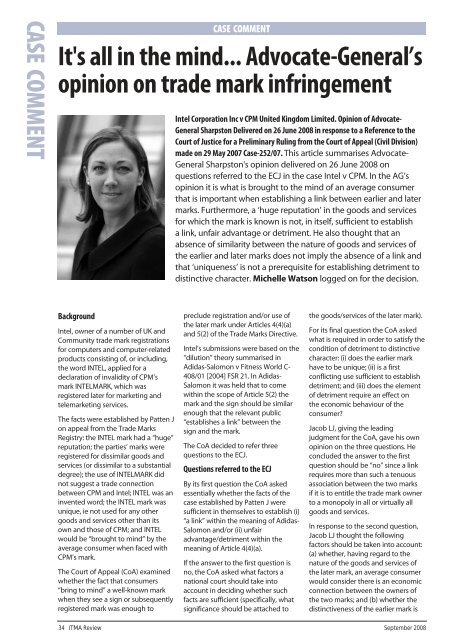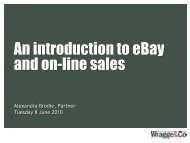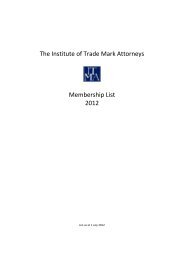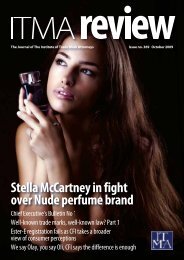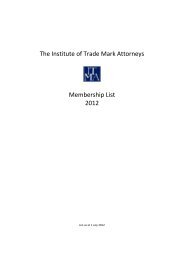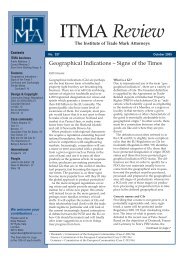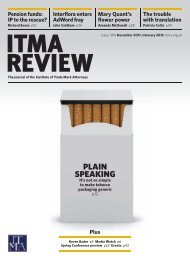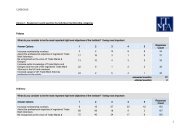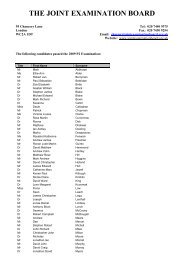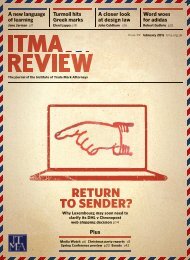The Trade Mark Rules 2008 - ITMA
The Trade Mark Rules 2008 - ITMA
The Trade Mark Rules 2008 - ITMA
You also want an ePaper? Increase the reach of your titles
YUMPU automatically turns print PDFs into web optimized ePapers that Google loves.
CASE COMMENT<br />
Background<br />
Intel, owner of a number of UK and<br />
Community trade mark registrations<br />
for computers and computer-related<br />
products consisting of, or including,<br />
the word INTEL, applied for a<br />
declaration of invalidity of CPM’s<br />
mark INTELMARK, which was<br />
registered later for marketing and<br />
telemarketing services.<br />
<strong>The</strong> facts were established by Patten J<br />
on appeal from the <strong>Trade</strong> <strong>Mark</strong>s<br />
Registry: the INTEL mark had a “huge”<br />
reputation; the parties’ marks were<br />
registered for dissimilar goods and<br />
services (or dissimilar to a substantial<br />
degree); the use of INTELMARK did<br />
not suggest a trade connection<br />
between CPM and Intel; INTEL was an<br />
invented word; the INTEL mark was<br />
unique, ie not used for any other<br />
goods and services other than its<br />
own and those of CPM; and INTEL<br />
would be “brought to mind” by the<br />
average consumer when faced with<br />
CPM’s mark.<br />
<strong>The</strong> Court of Appeal (CoA) examined<br />
whether the fact that consumers<br />
“bring to mind” a well-known mark<br />
when they see a sign or subsequently<br />
registered mark was enough to<br />
CASE COMMENT<br />
It's all in the mind... Advocate-General’s<br />
opinion on trade mark infringement<br />
34 <strong>ITMA</strong> Review<br />
Intel Corporation Inc v CPM United Kingdom Limited. Opinion of Advocate-<br />
General Sharpston Delivered on 26 June <strong>2008</strong> in response to a Reference to the<br />
Court of Justice for a Preliminary Ruling from the Court of Appeal (Civil Division)<br />
made on 29 May 2007 Case-252/07. This article summarises Advocate-<br />
General Sharpston's opinion delivered on 26 June <strong>2008</strong> on<br />
questions referred to the ECJ in the case Intel v CPM. In the AG’s<br />
opinion it is what is brought to the mind of an average consumer<br />
that is important when establishing a link between earlier and later<br />
marks. Furthermore, a ‘huge reputation’ in the goods and services<br />
for which the mark is known is not, in itself, sufficient to establish<br />
a link, unfair advantage or detriment. He also thought that an<br />
absence of similarity between the nature of goods and services of<br />
the earlier and later marks does not imply the absence of a link and<br />
that ‘uniqueness’ is not a prerequisite for establishing detriment to<br />
distinctive character. Michelle Watson logged on for the decision.<br />
preclude registration and/or use of<br />
the later mark under Articles 4(4)(a)<br />
and 5(2) of the <strong>Trade</strong> <strong>Mark</strong>s Directive.<br />
Intel’s submissions were based on the<br />
“dilution” theory summarised in<br />
Adidas-Salomon v Fitness World C-<br />
408/01 [2004] FSR 21. In Adidas-<br />
Salomon it was held that to come<br />
within the scope of Article 5(2) the<br />
mark and the sign should be similar<br />
enough that the relevant public<br />
“establishes a link” between the<br />
sign and the mark.<br />
<strong>The</strong> CoA decided to refer three<br />
questions to the ECJ.<br />
Questions referred to the ECJ<br />
By its first question the CoA asked<br />
essentially whether the facts of the<br />
case established by Patten J were<br />
sufficient in themselves to establish (i)<br />
“a link” within the meaning of Adidas-<br />
Salomon and/or (ii) unfair<br />
advantage/detriment within the<br />
meaning of Article 4(4)(a).<br />
If the answer to the first question is<br />
no, the CoA asked what factors a<br />
national court should take into<br />
account in deciding whether such<br />
facts are sufficient (specifically, what<br />
significance should be attached to<br />
the goods/services of the later mark).<br />
For its final question the CoA asked<br />
what is required in order to satisfy the<br />
condition of detriment to distinctive<br />
character: (i) does the earlier mark<br />
have to be unique; (ii) is a first<br />
conflicting use sufficient to establish<br />
detriment; and (iii) does the element<br />
of detriment require an effect on<br />
the economic behaviour of the<br />
consumer?<br />
Jacob LJ, giving the leading<br />
judgment for the CoA, gave his own<br />
opinion on the three questions. He<br />
concluded the answer to the first<br />
question should be “no” since a link<br />
requires more than such a tenuous<br />
association between the two marks<br />
if it is to entitle the trade mark owner<br />
to a monopoly in all or virtually all<br />
goods and services.<br />
In response to the second question,<br />
Jacob LJ thought the following<br />
factors should be taken into account:<br />
(a) whether, having regard to the<br />
nature of the goods and services of<br />
the later mark, an average consumer<br />
would consider there is an economic<br />
connection between the owners of<br />
the two marks; and (b) whether the<br />
distinctiveness of the earlier mark is<br />
September <strong>2008</strong>


